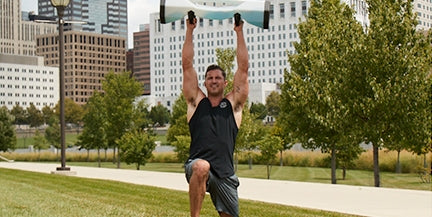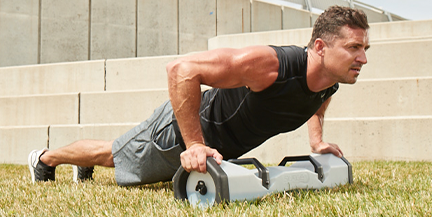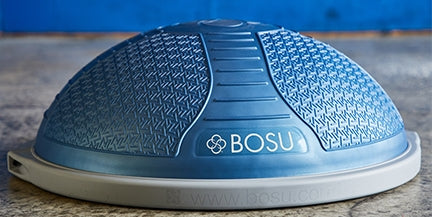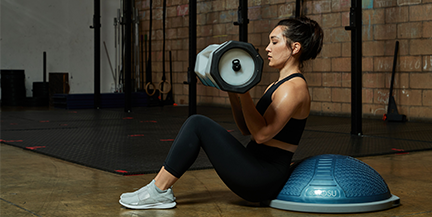Three BOSU® Exercises You’ve Probably Never Done Before

After 20 years of being at the forefront of balance, functional and neuromotor training, the BOSU® Balance Trainer has remained a valuable client training tool.
If you’ve been an advocate for many of those years, you could be forgiven for relying on ‘old staples’ to get you through your programming needs. It’s human nature to follow the path of least resistance, and for many trainers we find the same key exercises are utilized across clients regardless of individual needs.
Many trainers get caught using a cookie-cutter approach between clients which ignores imbalances, movement requirements, variety and adaptability between people. At best, it doesn’t drive the quality of training forward for the client, and at worst, it hinders progress over time as training considerations are not being met.
There are three fundamental questions any trainer should ask pre-programming when using the BOSU® Balance Trainer:
- Why is this exercise necessary for my client?
- How does this exercise benefit their training and/or life?
- What difference does it make performing the exercise on the BOSU® Balance Trainer?
When we talk about neuromotor training, we’re looking at synergy between the brain, nervous, and musculoskeletal systems. First, assess individual clients according to their biggest needs and address those first. These are often more rudimentary and foundational exercises that form a base for training that is to follow. You can’t build for speed, agility or power unless you start with balance, and we know the Balance Trainer is the very best tool to work with.
Secondly, understand that not all exercises are enhanced using the BOSU® Balance Trainer. It’s simple exercise science to know that many true power and strength-based moves are inhibited when placed on any unstable surface, so we need to determine if the Balance Trainer enhances a movement and increases the benefits. There are a huge number of benefits to working out with the Balance Trainer, so we have to make the prescription appropriate and meaningful.
The following three exercises showcase an upper body, lower body and core exercise. Each feature a different movement pattern and can be adapted for all fitness levels. They fall outside the ‘staple exercises’ we get into a rut of prescribing and can be used to stimulate creativity to continue providing quality programming.
Exercise 1: Tick Tock
Body Region: Lower Body
Training Modality: Balance; Muscular Endurance
Description: In this drill, the Trainer calls a foot (either Right or Left) and a number between 1 and 12 as in a clock face. The client must do a single leg hop, landing on the correct foot with the toes pointing at the appropriate number on the clock face. You’ll need to establish where 12 o’clock is to begin with and work from there. E.g. ‘Right foot, 3 o’clock / Left foot, 11 o’clock)
Technique:
- Start with one foot over the logo imprint on top of the BOSU® Balance Trainer
- One-foot take-off and landing on the nominated foot
- Stick the landing to ensure deceleration of force and muscle loading
Benefits:
- Ankle stability
- Leg muscle activation for stability and endurance
- Auditory and sensory benefits for landing in the correct clock position on the correct foot
- Balance challenge provided by the unstable surface of the dome
- Precision challenge to land in the correct o’clock position
Exercise 2: Push Rotate Ladder
Body Region: Upper Body
Training Modality: Muscular Endurance; Cardiovascular Endurance(at speed); Stability
Description: With the Balance Trainer in platform side up position, complete one push-up. Then, jump the feet in wide and rotate to one side with the Balance Trainer. Jump 180° to face the opposite direction and repeat, rotating to the opposite side. Once back in the original start position, repeat the sequence doing two push-ups, two rotations and the 180° jump. Repeat the sequence moving up the ladder to the desired number of even reps. Once achieved, you have the option of working in reverse with the repetitions to ladder the sequencing back down.
Technique:
- Start platform side up, dropping the chest to the platform on the push-up
- Brace the core, drive the hips, and raise one heel in the direction of the rotation
- Stick the 180° jump for stability and set your position before repeating the sequence
Benefits:
- Shoulder stability in both phases of the push-up
- Core stability
- Cardio endurance if performed at speed
- Muscular control for accurate start and stop positions in all movements
Exercise 3: Plyo Beast
Body Region: Core
Training Modality: Power; Muscular Endurance; Stability
Description: Balance on top of the dome with your hands and feet on the dome in each quadrant. Keeping the knees off the surface of the dome, start using an easier option of lifting one leg at a time, before advancing to ‘pop’ the feet up off the dome as a complete unit.
Technique:
- Have the hands and feet placed on the surface of the dome in each quadrant
- Raise the knees off the dome an inch or two (lower is harder)
- Brace the core
- Push through the arms and legs to lift the feet explosively off the dome
Benefits:
- Core stability
- Shoulder stability
- Abdominal wall and supporting trunk muscle activation for power
- Secondary benefits to upper and lower body muscles in the push-off and landing phases
Greg Sellar is a member of the BOSU® Master Trainer Team and Education Programming Faculty. He is an accredited ICF-Coach with certifications in Coaching, Leadership & Mentoring, as well as being an LSI (Lifestyles Inventory) accredited Practitioner. He splits his time between the fitness industry and delivering leadership workshops and keynote speeches to major corporate clients in the UK, USA and Australia. He has recently launched his 90-day LIFEHACK program focusing on mindset and behavior change, available via his website GREGSELLAR.COM.




